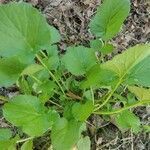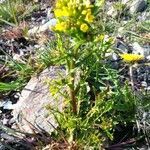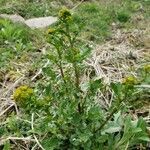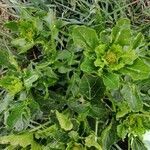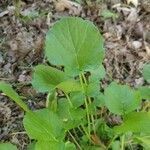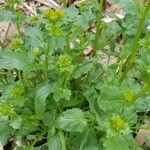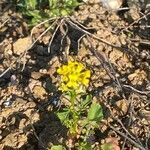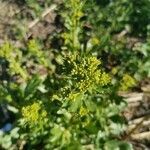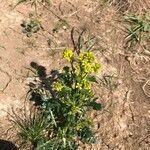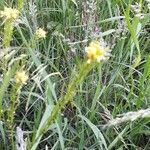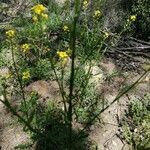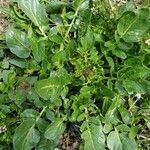Biennial, sometimes short-lived perennial. Stems branched above, (20)-40-60-(90) cm tall. Rosette lvs deeply lyrate-pinnatifid, sparsely hairy, especially on petiole and margins, or glabrous, (3)-7-25 × (1)-2-6 cm; terminal lobe ovate to oblong; lateral lobes in (4)-5-8 or more pairs, the distal pair usually > width of terminal lobe; margins entire, sinuate, toothed or lobed. Upper stem lvs deeply pinnatifid with deflexed lobes at base; terminal lobe narrow-oblong or cuneiform, usually 3-lobed or 3-fid; lateral lobes in (1)-2 pairs, linear. Racemes to 30 cm tall; pedicels erecto-patent at fruiting, c. 5 mm long. Sepals glabrous, 3-4 × 0.8-1.5 mm. Petals 6-8 × 2-3 mm. Silique erecto-patent, (30)-40-70 × 1.5-2.5 mm; style 1-1.5 mm long.
Erect biennial herbs up to 75 cm high, glabrous or nearly so. Basal leaves in a rosette, 5-20 cm long, pinnate, 6-10-jugate; lateral lobes broad, short, rounded, entire or sinuate; terminal lobe larger, ovate to subcircular, its base somewhat cordate. Lower stem haves with 5-7 pairs of narrower, ± oblong lobes. Upper stem leaves with a few narrow lobes, sessile. Flowers small; petals 5-7 mm long, narrowly obovate, bright yellow. Siliquae 3-7 cm long, 1.5-2 mm in diameter, linear, ascending-arcuate on stout pedicels 4-8 mm long; style 1-2 mm long. Seeds oval, ±2.5 x 1.2 mm.
Erect, 3–8 dm, peppery; lower lvs oblong, to 2 dm, with 4–10 pairs of ovate, repand lateral lobes; cauline lvs smaller, with 3–8 pairs of oblong to linear, mostly entire lateral lobes; pet 6–8 mm; mature pedicels 3.5–7 × 1.2–1.8 mm; frs widely ascending, straight or nearly so, 4.5–7 cm, the beak 1–2.5 mm; 2n=16. Native of Eurasia, naturalized in damp soil, fields, roadsides, etc. from Nf. to Wash., s. to Fla. and Calif. Apr.–June. (Campe v.)
Biennial herb, 0.3-0.9 m high, erect, glabrous or puberulous. Leaves: basal leaves rosulate, pinnate, 6-10-jugate, lateral lobes short, broad, rounded, margins entire or sinuate, terminal lobes larger, ovate to subcircular; lower cauline leaves in 5-7 pairs, oblong, upper ones sessile, few, lobes narrow. Flowers small. Petals 5-7 mm long, obovate, bright yellow. Fruit a linear siliqua, ascending-arcuate, on stout pedicels. Seeds oval.
A cabbage family herb. The leaves are dark smooth and shiny. They come from the ground in many stemmed rings. Each stem has leaflets arranged in 2 rows. There is a large rounded leaflet at the end. The flowering stem can be 60 cm high. The flowers are bright yellow. The seed pods are narrow and like a cylinder. There is a short point at the end.
Biennial to 75 cm tall, erect, usually glabrous. Basal leaves lyrate-pinnatisect with 5–10 pairs of lateral lobes, petiolate. Sepals erect, to 3 mm long. Petals 5–7 mm long. Siliqua linear 30–70 mm long, 1.5–2 mm wide; style persistent 1–2 mm long; pedicels curved, spreading, stout, 4–8 mm long. Seeds elliptic, 2.5 mm long.
